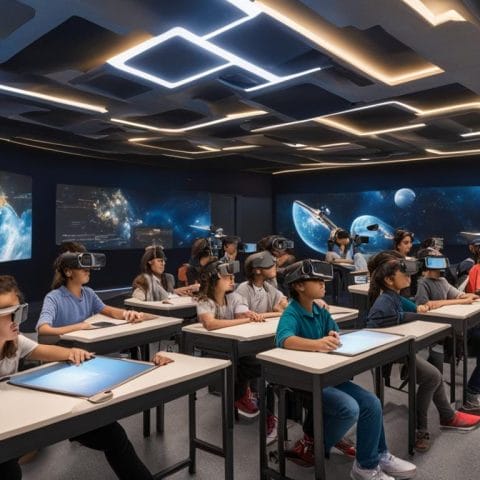Did you know that over 70% of educators think blended learning makes students more engaged and ready for the digital world? Schools are now using this modern way of teaching more often. It mixes online learning with traditional classroom time for a better learning experience.
This guide will cover the key tools, hardware, and practices needed for blended learning. With the right tools and resources, teachers can improve their teaching and make learning fun. Hyperspace is leading the way with solutions to help educators and schools use blended learning well.
Key Takeaways
- Blended learning combines online and in-person education, boosting engagement.
- A significant majority of educators support the effectiveness of blended learning.
- Technology requirements for blended learning include essential hardware and software.
- Online learning platforms play a crucial role in facilitating blended education.
- Understanding blended learning tools can enhance the overall learning experience.
Introduction to Blended Learning
Blended learning is a new way that mixes traditional teaching with online tools. It lets teachers use technology to make their lessons better. This method helps teachers see how technology can improve their teaching.
The benefits of blended learning are many. Students can learn anytime and anywhere, making their schedules more flexible. This makes them more likely to take part in class. Also, using different teaching methods helps students remember information better since they learn in various ways.
Adding technology to the classroom is a powerful teaching method. Teachers can give personalized feedback, track student progress, and make learning fun. This way, students learn better because they can choose how they learn. It also makes them more independent in their studies.
Learning about blended learning is key to using it well in schools. As more schools use this method, it’s important for teachers and students to understand its value.
Understanding Blended Learning
Blended learning mixes traditional teaching with online learning. This creates a flexible and engaging way to learn. It meets the diverse needs of students by using different learning methods.
There are many types of blended learning, each fitting different learning styles. These models help teachers tailor their teaching. For example, the flipped classroom model lets students learn at home and discuss in class. This improves understanding and memory.
Technology changes fast, affecting how we teach. Schools use blended learning to meet students’ needs, promoting self-learning and teamwork. By adapting, teachers can make learning exciting and lead to better results.
| Blended Learning Model | Description | Benefits |
|---|---|---|
| Flipped Classroom | Students learn at home and engage in activities in class. | Promotes active learning and peer collaboration. |
| Rotation Model | Students rotate between different learning modalities. | Caters to individual learning preferences. |
| Self-Blend Model | Students choose additional online courses alongside traditional courses. | Allows personalization of learning pathways. |
| Online Driver Model | Online learning supports the majority of instruction. | Increases accessibility and flexibility. |
Technology Requirements for Blended Learning
Blended learning needs specific technology to work well. Schools must focus on the right hardware and network connections. This ensures students get a good learning experience.
Essential Hardware and Software
For blended learning, you need the right tools. Schools usually need:
- Computers or laptops for students and teachers
- Tablets for easy access to digital materials
- Smartboards for interactive lessons
Software is also key. It includes:
- Learning Management Systems (LMS) to keep track of student progress
- Apps for virtual classrooms to keep students engaged
- Tools for making multimedia educational content
Network and Connectivity Needs
Strong network connectivity is vital. It affects how students and teachers access resources. Key network needs are:
- Fast internet for smooth streaming of content
- Stable connections for online tests and teamwork
- Wi-Fi in classrooms and study areas
With the right hardware and network setup, schools can support blended learning well.
| Category | Essential Hardware | Software Solutions | Network Requirements |
|---|---|---|---|
| Students | Computers, Tablets | LMS, Virtual Classroom Apps | High-Speed Internet |
| Educators | Smartboards, Laptops | Content Creation Tools | Stable Wi-Fi Access |
| Institutions | Dedicated Computer Labs | Administrative Software | Robust Networking Infrastructure |
Blended Learning Tools

Using blended learning tools is key in today’s education. They help create a full learning environment. Teachers and school leaders use technology to meet the needs of all students. There are many platforms that make blended learning better, including tools for virtual classrooms that allow students to interact in real time.
Virtual Classroom Software
Virtual classroom software is crucial for online learning. It lets teachers hold live classes and talk with students in real time. Tools like video calls change old teaching ways into something more interactive. Features like sharing screens and group chats make classes more fun for students.
This technology is key for blended learning tools that fit different learning styles.
Synchronous and Asynchronous Tools
It’s important for teachers to know the difference between synchronous and asynchronous tools. Synchronous tools, like live video classes or webinars, offer instant feedback and interaction. Asynchronous tools, like pre-recorded lessons and forums, let students learn at their own pace.
This flexibility helps students with different schedules and learning styles. Teachers can pick the right tools to improve their teaching methods. This leads to better learning results. For more info on blended learning tools, check out this resource or see how adaptive learning helps by visiting this page.
Designing Your Blended Course
Creating a blended course starts with good course design. It’s key to mix online learning activities and onsite learning activities well. This mix keeps students interested and makes sure they reach the course goals. By combining these parts, teachers can make learning more fun and deep.
Blending Learning Activities Online
Online learning is a big part of blended courses. Use many digital tools to fit what students like. Some good options are:
- Interactive videos and simulations
- Discussion forums for peer engagement
- Quizzes and assessments to gauge understanding
- Collaborative projects using cloud-based tools
These online activities make learning active and flexible. Students can learn at their own speed. Using technology well can really improve the online part of a course.
Blending Learning Activities Onsite
Onsite activities are also crucial for blended courses. They help students work together and think deeply. Good onsite strategies are:
- Group discussions and brainstorming sessions
- Hands-on workshops and labs
- Presentations and peer reviews
- Real-world scenario problem solving
Combining onsite and online parts makes learning exciting and varied. This way, teachers can give students a full learning experience. It helps students meet their goals well.
LMS Integration
Integrating a Learning Management System (LMS) is key for good blended learning. These systems help manage online courses well. They let teachers make, manage, and share course materials easily. With a strong LMS, schools can work better and make learning better for students.
Here are the main steps for LMS integration:
- Assess your needs: Figure out what your courses need and pick the best features for your school.
- Choose the right platform: Look for online platforms that meet your goals, like being easy to use and growing with your needs.
- Customize the system: Make the LMS fit your classes by adding important resources, tests, and ways to track progress.
- Train educators and students: Teach everyone how to use the LMS, so both teachers and students feel at ease with it.
By using LMS well, schools can handle courses better, keep track of student progress, and share resources easily. Schools can get help from experts like Hyperspace to make this integration smooth. For more info on LMS features and benefits, check out blended learning features.
Interactive Multimedia Resources
Interactive multimedia resources are key to making learning fun and effective. They use videos, simulations, and games to grab students’ attention and get them involved. This fits well with blended learning, which mixes old-school teaching with new digital tools.
These tools make learning more real and exciting. Students get more motivated and remember more when they use them. Plus, they offer many ways for students to connect with the material, fitting different learning styles.
Here’s a look at traditional and interactive multimedia resources:
| Aspect | Traditional Resources | Interactive Multimedia Resources |
|---|---|---|
| Engagement Level | Moderate | High |
| Learning Styles Addressed | Visual, Auditory | Visual, Auditory, Kinesthetic |
| Flexibility in Learning | Limited | Dynamic |
| Feedback Mechanism | One-way | Interactive, Instant |
To get the most out of interactive multimedia resources, teachers should check out different options and see what works best. Using these tools in blended learning gives students the best of both worlds for a richer learning experience.
Digital Collaboration Tools

In blended learning, teamwork is key for better student engagement and results. Digital tools help students connect, share, and work together from anywhere. This is vital for teamwork in education.
Tools like Google Workspace and Microsoft Teams make real-time collaboration easy. Students can talk and work together instantly. Collaborative whiteboards add to this by offering a space for brainstorming and visualizing ideas.
The following table shows different digital tools and what they offer:
| Tool | Key Features | Benefits for Teamwork |
|---|---|---|
| Google Workspace | Document sharing, real-time editing, integrated chat | Encourages participation and instant feedback |
| Microsoft Teams | Video conferencing, channel collaboration, task assignment | Simplifies project management and communication |
| Collaborative Whiteboards | Visual brainstorming, drawing tools, sticky notes | Enhances creative problem-solving and expression |
Using these tools creates a space for students to work together well in education. They help students adjust to different learning styles, making online and in-person learning smooth.
Conclusion
Thriving in blended learning needs a strategic plan. It’s about using the right tech and teaching methods. Teachers must use important tools for teaching and working together. They should also use online and in-person activities in their courses.
This approach makes learning more exciting and engaging. As education changes, staying flexible is crucial. Schools and teachers who keep up with new tech can improve education quality. This helps students get ready for the future.
Hyperspace is leading the way in education with its custom solutions. This helps teachers and schools adapt to changes. It means blended learning will keep offering great experiences for everyone. It will help students grow and succeed in different learning settings.
FAQ
What is blended learning?
Blended learning mixes online tools with traditional classroom teaching. It makes learning better.
What technology requirements are necessary for effective blended learning?
You need computers, tablets, and smartboards for blended learning. Also, software like Learning Management Systems (LMS) and virtual classroom tools are key. Plus, strong internet is crucial for online access.
What are some popular blended learning tools?
Tools like Zoom and Microsoft Teams are popular for virtual classrooms. Google Workspace helps with teamwork and learning projects. These tools make learning interactive and improve communication.
How do synchronous and asynchronous tools differ?
Synchronous tools are for live video lectures and real-time chats. Asynchronous tools let students learn at their own pace with pre-recorded lessons and forums.
How can I design a blended learning course effectively?
Create a blended course by combining online and in-class activities. Use different learning methods to keep students engaged and meet course goals.
What role does an LMS play in blended learning?
An LMS is crucial for blended learning. It helps manage courses, track student progress, and share resources. It’s vital for teachers and students.
How do interactive multimedia resources enhance the learning experience?
Tools like videos and simulations make learning fun and interactive. They encourage students to take part and learn better.
What are the benefits of digital collaboration tools in education?
Digital tools help students work together and share ideas. They support group projects and improve teamwork in both online and classroom settings. This leads to better learning outcomes.





